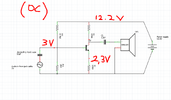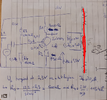GreenGecko7
New Member
Dear all, nice to meet you !
I recently invested in some tools to build amplifiers (my first oscilloscope + all-rounder C and R kits.). My end goal is to build an AM radio.
I have some basic knowledge in electronics : I have studied transistors and OP Amp functioning during my college masters degree. I also have a few Arduino projects under my belt.
However my 2 last tries at building a functiuning Class A amplifier failed. I need some help to understand why !
I based the diagram on this famous video :
And I adapted the values to fit my 12.2V switch-mode power supply.
Attached the schematic, in red are the DC measurements made via oscilloscope/multimeter.
Also, no AC component survives the first capacitor : the oscilloscope probing remains flat at +3V DC (DC coupling) when probed on the transistor base with reference on the ground.
Can you help me understand what fails, and suggest me fixes?
I can probe additionnal points if you tell me what to look for specifically.
Thanks a lot in advance !
Benjamin, from France
I recently invested in some tools to build amplifiers (my first oscilloscope + all-rounder C and R kits.). My end goal is to build an AM radio.
I have some basic knowledge in electronics : I have studied transistors and OP Amp functioning during my college masters degree. I also have a few Arduino projects under my belt.
However my 2 last tries at building a functiuning Class A amplifier failed. I need some help to understand why !
I based the diagram on this famous video :
Attached the schematic, in red are the DC measurements made via oscilloscope/multimeter.
Also, no AC component survives the first capacitor : the oscilloscope probing remains flat at +3V DC (DC coupling) when probed on the transistor base with reference on the ground.
Can you help me understand what fails, and suggest me fixes?
I can probe additionnal points if you tell me what to look for specifically.
Thanks a lot in advance !
Benjamin, from France




